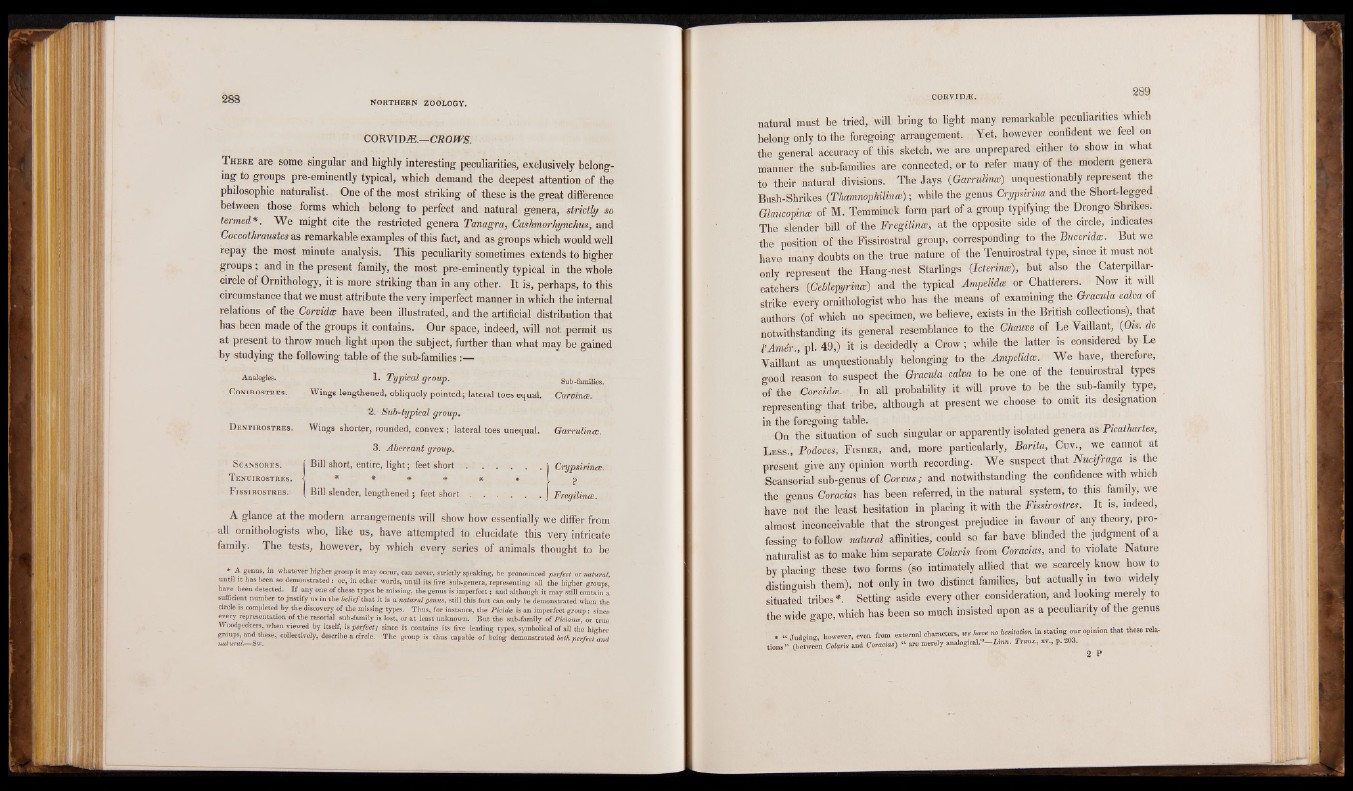
CORVIM3.—CROWS.
T hebe are some singular and highly interesting peculiarities, exclusively belonging
to groups pre-eminently typical, which demand the deepest attention of the
philosophic naturalist. One of the most striking of these is the great difference
between those forms which belong to perfect and natural genera, strictly so
termed*. We might cite the restricted genera Tanagra, Cashmorhynchus, and
Coccothraustes as remarkable examples of this fact, and as groups which would well
repay the most minute analysis. This peculiarity sometimes extends to higher
groups, and in the present family, the most pre-eminently typical in the whole
circle of Ornithology, it is more striking than in any other. It is, perhaps, to this
circumstance that we must attribute the very imperfect manner in which the internal
relations of the CorvidtE have been illustrated, and the artificial distribution that
has been made of the groups it contains. Our space, indeed, will not permit us
at present to throw much light upon the subject, further than what may be gained
by studying the following table of the sub-families:—
Analogies. 1. Typical group. Sub-families.
CoNIROSTRES. Wings lengthened, obliquely pointed; lateral toes equal. Corvince.
2. Sub-typical group.
D en t ir o st r e s. Wings shorter, rounded, convex; lateral toes unequal. Garrulincc.
3. Aberrant group.
SCANSORES. [ Bill short, entire, light; feet short . . . . 1 Crypsirince.
T en u iro st re s. < * * * * * * 1 ?
F issir o st r e s. [ Bill slender, lengthened; feet short . . . . . . | Fregilinas.
A glance at the modern arrangements will show how essentially we differ from
all ornithologists who, like us, have attempted to elucidate this very intricate
family. The tests, however, by which every series of animals thought to be
* A genus, in whatever higher group it may occur, can never, strictly speaking, be pronounced perfect or natural,
until it has been so demonstrated : or, in other words, until its five sub-genera, representing all the higher groups,
have been detected. ^ If any one of these types be missing, the genus is imperfect; and although it may still contain a
sufficient number to justify us in the belief that it is & natural genus, still this fact can only be demonstrated when the
circle is completed by the discovery of the missing types. Thus, for instance, the Picidas is an imperfect group: since
every representation of the rasorial sub-family is lost, or at least-unknown. But the sub-family of Piciance, or true
Woodpeckers, when viewed by itself, is perfects since it contains its five leading types, symbolical of all the higher
groups, and these, collectively, describe a circle. The group is thus capable of being demonstrated both perfect and natural.—Sw.
natural must be tried, will bring to light many remarkable peculiarities which
belong only to the foregoing arrangement. Yet, however confident we feel on
the o-eneral accuracy of this sketch, we are unprepared either to show in what
manner the sub-families are connected, or to refer many of the modern genera
to their natural divisions. The Jays (Garrulinw) unquestionably represent the
Bush-Shrikes (Thamnophilinai); while the genus Crypsirim and the Short-legged
Glaucopinw of M. Temminck form part of a group typifying the Drongo Shrikes.
The slender bill of the Fregilinw, at the opposite side of the circle, indicates
the position of the Fissirostral group, corresponding to the Buceridw. But we
have many doubts on the true nature of the Tenuirostral type, since it must not
only represent the Hang-nest Starlings (Icterinm), but also the Caterpillar-
catchers (Ceblepyrina;) and the typical Ampelidcc or Chatterers. Now it will
strike every ornithologist who has the means of examining the Gracula calm of
authors (of which no specimen, we believe, exists in the British collections), that
notwithstanding its general resemblance to the Charne of Le Vaillant, (Ok. de
I’Amer., pi. 49,) it is decidedly a Crow; while the latter is considered by Le
Vaillant as unquestionably beionging to the Ampelidce. We have, therefore,
good reason to suspect the Gracula calm to be one of the tenuirostral types
of the Corrida;. In all probability it will prove to be the sub-family type,
representing that tribe, although at present we choose to omit its designation
in the On ftohree gsoitiunagt itoanb leo.f such singular or apparently isolated genera as Pical,h, artJes,
Less Podoces, Fisher, and, more particularly, Barita, Cuv., we cannot at
present give any opinion worth recording. We suspect that Nucifraga is the
Scansorial sub-genus of Corms.; and notwithstanding the confidence with which
the genus Coracias has been referred, in the natural system, to this family, we
have not the least hesitation in placing it with the Fissirostres. It is, indeed,
almost inconceivable that the strongest prejudice in favour of any theory, professing
to follow natural affinities, could so far have blinded the judgment of a
naturalist as to make him separate Colaris from Coracias, and to violate Nature
by placing these two forms (so intimately allied that we scarcely know how to
distinguish them), not only in two distinct families, but actually in two widely
situated tribes *. Setting aside every other consideration, and looking merely to
the wide gape, which has been so much insisted upon as a peculiarity of the genus
. J Judging, however, even from external characters, w M m S S j i S B “r 1“ 0 1 1 tte S e
tions " (beween Color« and Corooioj) “ are merely analogical.”—it»». Tram, xv., p. 203.